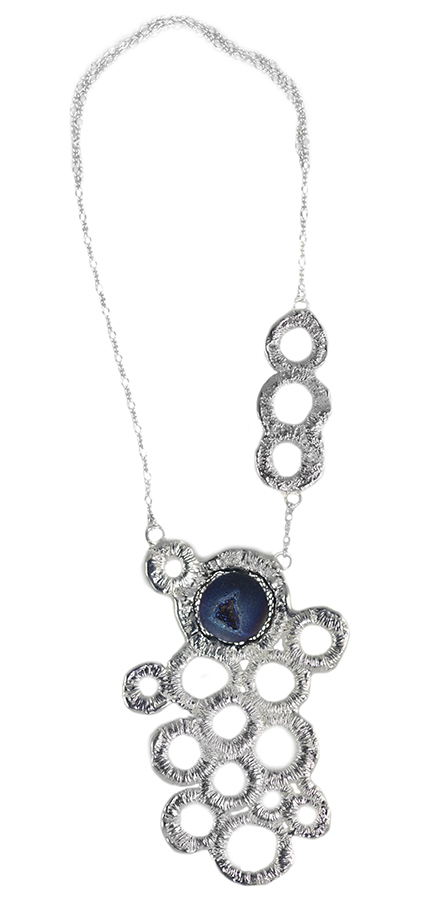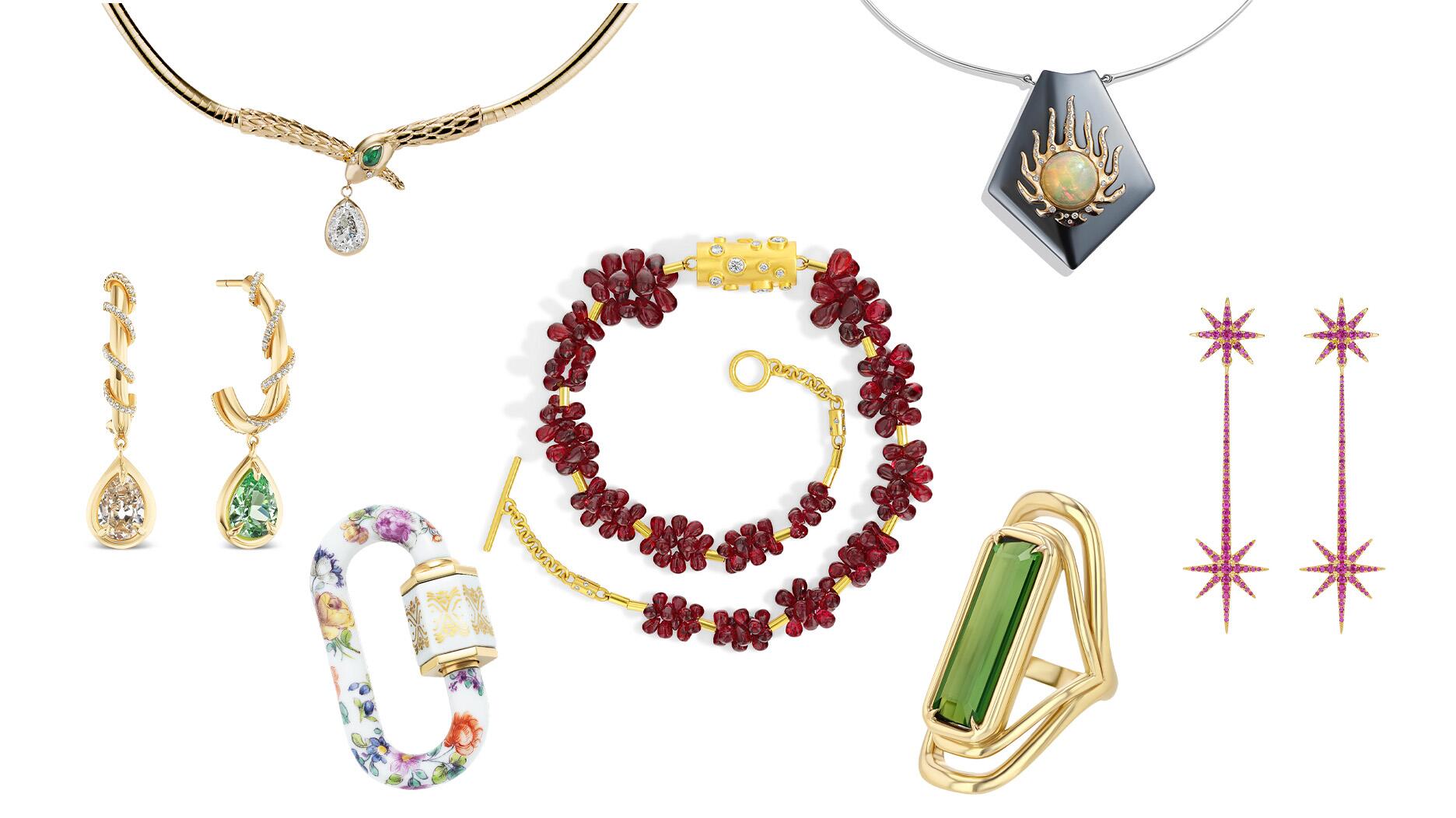The special-edition egg pendant ingested in a New Zealand jewelry store was recovered after a six-day wait.
A new take on lace
Designer Monika Knutsson breathes new life into old pieces of lace by dipping them in karat gold or sterling silver to create jewelry. Read more in Associate Editor Brecken Branstrator’s Q&A with the artist.
After getting her start in fashion, she eventually realized she could use the lace she found in other ways. The designer began dipping the pieces in karat gold, creating a unique look that celebrates the fabric pieces’ past as it brings them into the present.
Each piece is given a tag that includes its name, as well as the year and history of the lace’s creation and its former use.
Read on to learn more about Knutsson’s inspiration, design process and the exciting new things she has on the horizon for her jewelry line.
National Jeweler: How did you get started in jewelry and especially doing these kinds of pieces?
Monika Knutsson: I was working in France as a fashion designer for Isabel Marant. When we designed a vintage lace collection, I went to the flea market at Clignancourt to do research and find old lace pieces and garments. That is when I discovered this enormous treasure of old, beautiful lace, and I started collecting it.
The first piece of lace jewelry I made for myself. It was a cuff bracelet and it was stunning. My head started spinning and I continued all night to design lace jewelry. The possibilities were endless. Needless to say, I did not sleep that night.
Both of my grandmothers were lace makers. Dipping the lace in 24-karat gold is a way to honor not only their work, but all the other women that made lace by hand.
I moved back to the United States in 2008 with my large lace collection. In 2010, I founded the company in New York City. My studio is located on the Upper West Side in Manhattan. I make all the jewelry by hand. The lace is dipped in 24-karat gold, sterling silver or rose gold here in New York.
NJ: Take me through the process you use to create these intricate pieces.
MK: First, I find the lace and cut it according to a pattern. Then I hand-sew the jewelry together. For example, in the new collection I have a cuff called “Claudie.” It is a cuff made of circular lace from the 1960s. There I sew on a back to the cuff and then a silk tulle pouch under the lace to hold the
Now the pieces are ready for the metal. They are sprayed with a thin layer of copper and dipped in a batch of 24-karat gold or sterling silver. This process is long and requires a lot of hands-on supervision.
To finish, all my cuffs, bangles, collars and larger necklaces are signed and numbered and come with a piece of the original lace.

This is the “Margaret Rose” cuff, made using British crown lace made in 1936 to commemorate the coronation of King George VI in 1937, dipped in 24-karat gold. The cuff is named after one of King George VI's daughters ($895).
NJ: Where do you get the lace from? What do you look for in a piece of lace that you are going to use?MK: I get the lace at flea markets and small antique stores in the U.S., Paris, Berlin and Stockholm. I have to go through a lot of lace to find what I’m looking for, and I only buy a small percentage of what I see. The lace has to be open and made with a thin thread, like Bobbin lace or French laces such as Calais, Chantilly, or Valenciennes, so that it won’t clog when it’s dipped.
There is a great variation in lace. It can look modern, like the geometric bobbin lace from the 1930s, or have a vintage look like the Calais lace from the 1920s. I really enjoy the challenge of making new and surprising jewelry from the same material. And the pieces I created four or five years ago are still wearable today.
NJ: Do you get requests for custom pieces from lace that a client may already have?
MK: Yes, I do. An example would be when the bride-to-be mails me a small piece of lace from the bridal gown fitting. I will design jewelry (using that lace) for her to wear at the wedding.
Or the lace may come from an old wedding dress. The client will ask me to make jewelry for her wedding anniversary or another special occasion. Sometimes, the lace is from the great-grandmother or grandmother’s wedding dress and the grandchildren are the clients. They’ll also send me hand-made heirloom lace that has been in their family.
Though collection pieces still make up most of my business, custom now accounts for 20 percent. But I do have a large following in stores. What’s interesting is that my customers range anywhere in age from their mid-20s to their 70s.


On the left is the “Pauline” cuff from the Berlin 1920s collection, made using French Calais lace used in the 1920s dipped in rose gold ($900); on the right is the “Vickie” cuff bracelet from the fall/winter 2014/2015 collection, made from American circular Guipure lace from the 1970s dipped in 24-karat gold ($825).
NJ: Where do you see your collection going from here? Are there any new developments in the works?MK: There are several exciting developments. I see American handmade products getting more traction in fashion. As a result, I am using vintage and antique American-made lace, and I’m currently selling this jewelry through Martha Stewart’s “American Made” market.
In my fall/winter 2014 collection, there are also many pieces from American-made lace. In the coming collection for spring/summer 2015, there will only be American-made lace with lots of stones, including carnelian, white agate, black agate, amethyst and labradorite.
I am also introducing a bridal collection for spring 2015 with smaller earrings, small cuffs and bangles, hair pieces and a small necklace. This is all modern lace jewelry in dipped sterling silver and rose gold.


From the fall/winter 2014/2015 collection are the “Esther earrings” made from American circular Guipure lace from the 1970s dipped in rose gold and also featuring cabochon moonstone ($315) and the “Manon” double pendant necklace made from French circular Guipure lace from the 1960s with a blue geode embedded in one of the circles ($735).
NJ: Who are a few jewelry designers whose work you admire?MK: I love different types of work from very clean lines to intricate jewelry. Beauty is a given, but the jewelry should have elements of surprise and wonder. I love Manya & Roumen’s amazing animal jewelry, Ted Muehling’s clean lines and beautiful shapes, Anna Ruth Henriques’ painted glass jewelry, and Jacqueline Cullen’s Whitby jet jewelry with gold.
The Latest

The “Love and Desire” campaign is inspired by the magic that follows when one’s heart leads the way, said the brand.

Two awardees will receive free tuition for an educational course at the Swiss lab, with flights and lodging included.

How Jewelers of America’s 20 Under 40 are leading to ensure a brighter future for the jewelry industry.

Berta de Pablos-Barbier will replace Alexander Lacik at the start of January, two months earlier than expected.


Sotheby’s held its first two jewelry sales at the Breuer building last week, and they totaled nearly $44 million.

Winners will receive free registration and lodging for its fourth annual event in Detroit.

Roseco’s 704-page catalog showcases new lab-grown diamonds, findings, tools & more—available in print or interactive digital editions.

Here are six ideas for making more engaging content for Instagram Reels and TikTok, courtesy of Duvall O’Steen and Jen Cullen Williams.

The honorees include a notable jewelry brand, an industry veteran, and an independent retailer.

Carlos Jose Hernandez and Joshua Zuazo were sentenced to life without the possibility of parole in the 2024 murder of Hussein “Sam” Murray.

Yood will serve alongside Eduard Stefanescu, the sustainability manager for C.Hafner, a precious metals refiner in Germany.

The New Orleans jeweler is also hosting pop-up jewelry boutiques in New York City and Dallas.

Set in a Tiffany & Co. necklace, it sold for $4.2 million, the highest price and price per carat paid for a Paraíba tourmaline at auction.

The jeweler’s “Deep Freeze” display showcases its iconic jewelry designs frozen in a vintage icebox.

Take luxury gifting to new heights this holiday season with the jeweler’s showstopping 12-carat sphene ring.

This year's theme is “Unveiling the Depths of the Ocean.”

In its annual report, Pinterest noted an increase in searches for brooches, heirloom jewelry, and ‘80s luxury.

Starting Jan. 1, customers can request the service for opal, peridot, and demantoid garnet.

The 111-year-old retailer celebrated the opening of its new location in Salem, New Hampshire, which is its third store in the state.

The new catalog features its most popular chains as well as new styles.

The filmmaker’s personal F.P. Journe “FFC” prototype was the star of Phillips’ recent record-setting watch auction in New York.

The new location in the Design District pays homage to Miami’s Art Deco heritage and its connection to the ocean.

Inflations, tariffs, and politics—including the government shutdown—were among consumers’ top concerns last month.

“Longtime favorite” presenters, as well as first-time speakers, will lead talks and workshops at the annual event in Tucson next year.

Silas Smith of Meridian Metalworks won the challenge with his pendant that blends Australian and American landscapes.

The sale of the 31.68-carat, sunset-hued stone was part of Sotheby’s first series of events and auctions in Abu Dhabi.




























